Charles E W Bean, Diaries, AWM38 3DRL 606/2/1 - January - March 1915 - Part 3
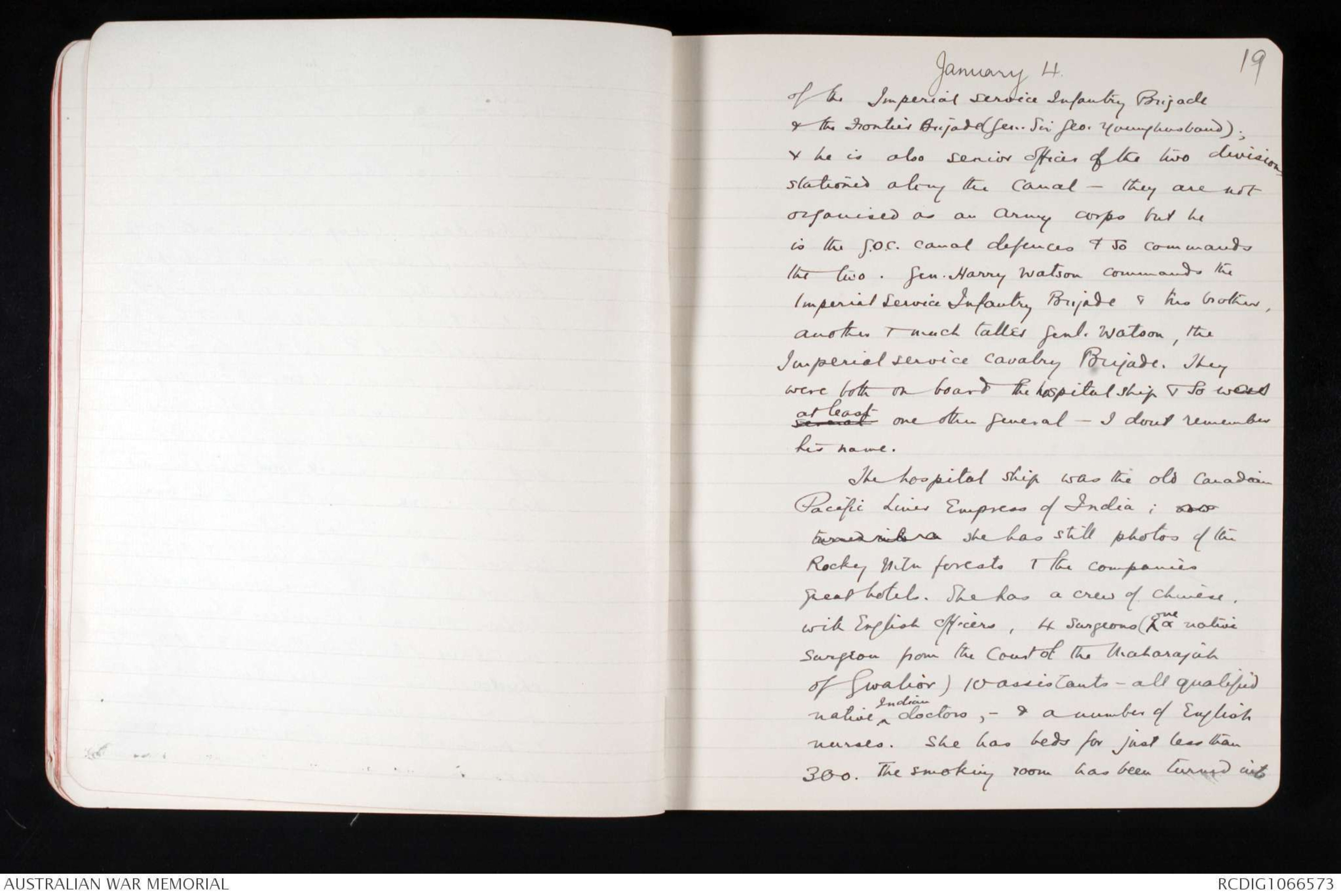
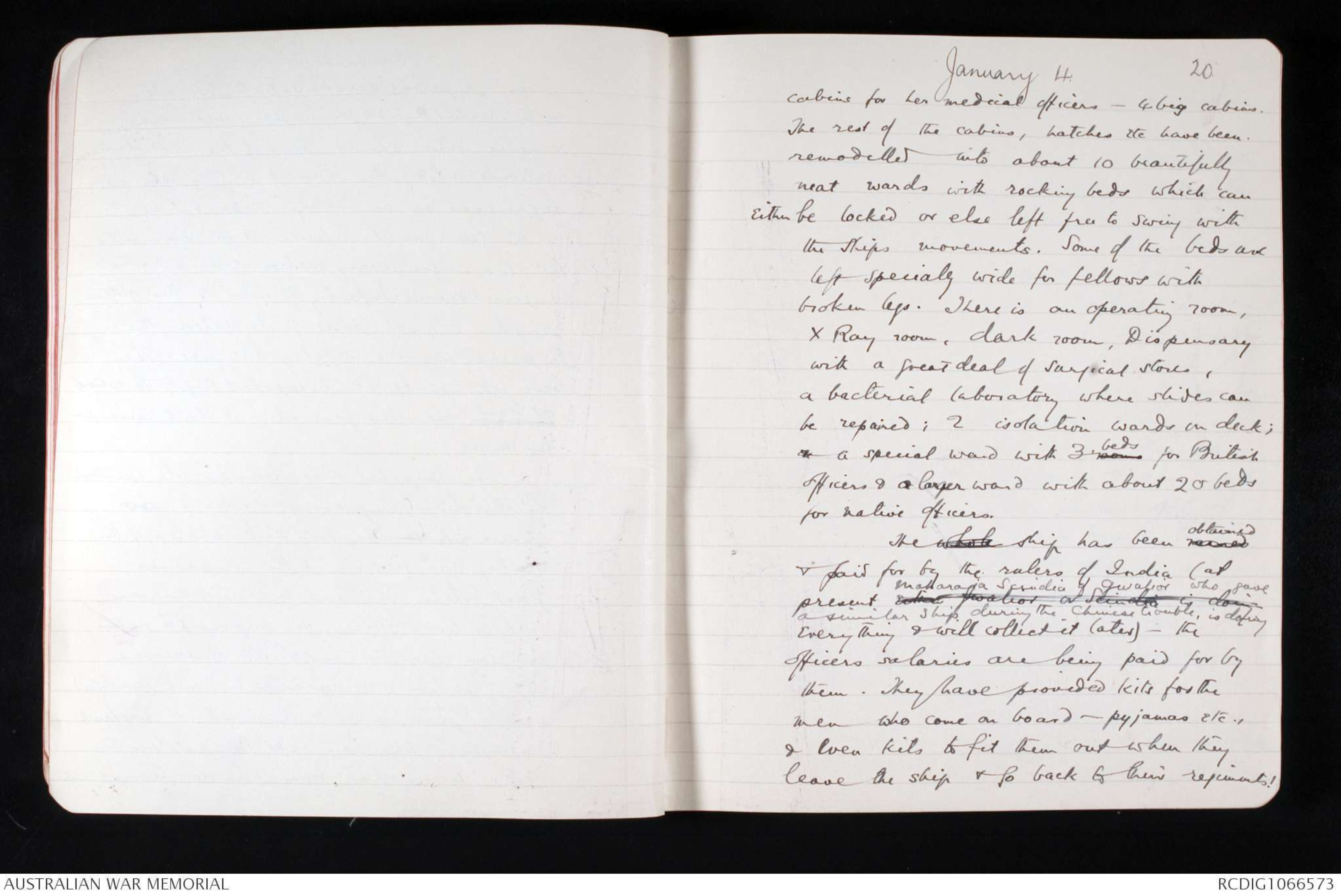
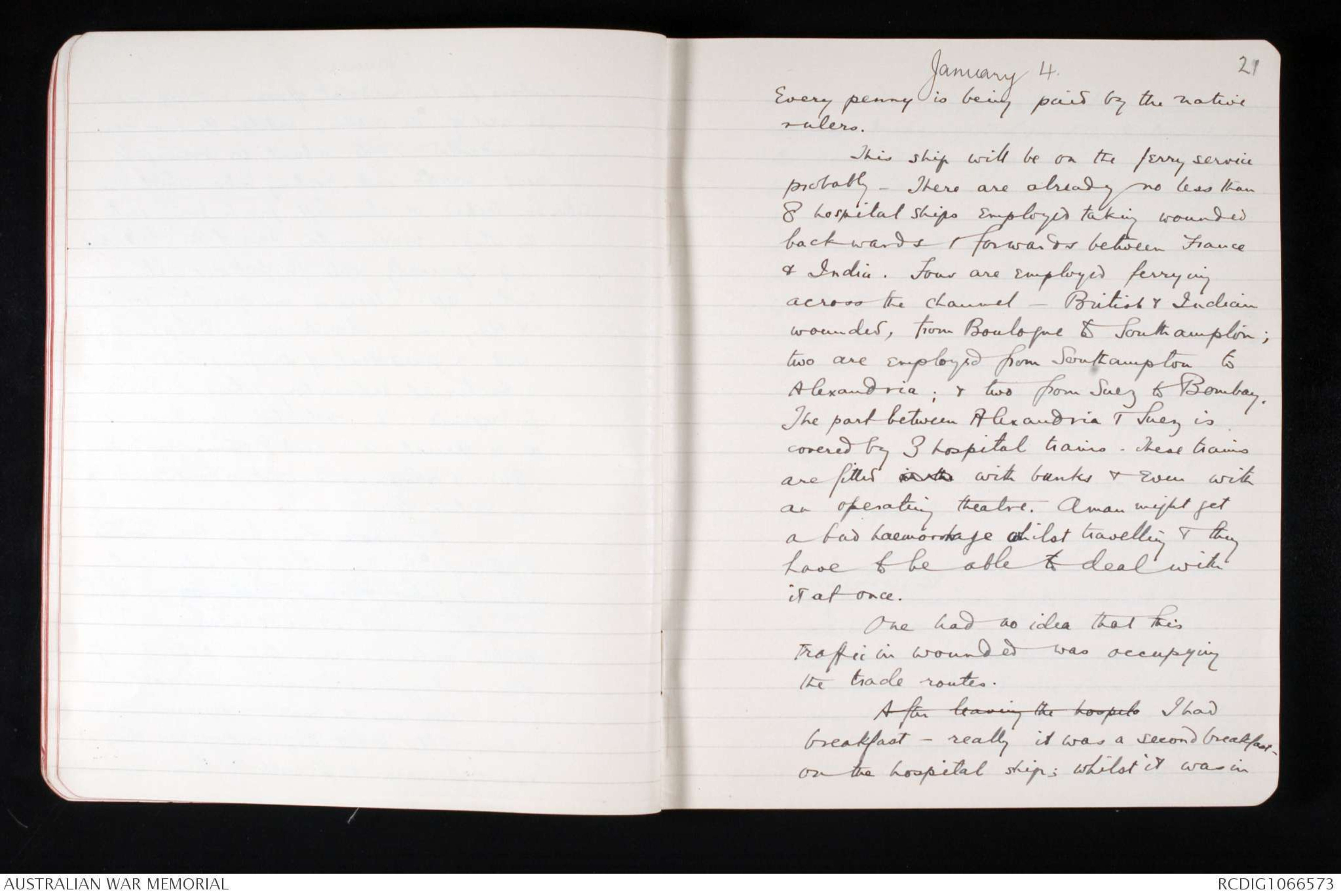
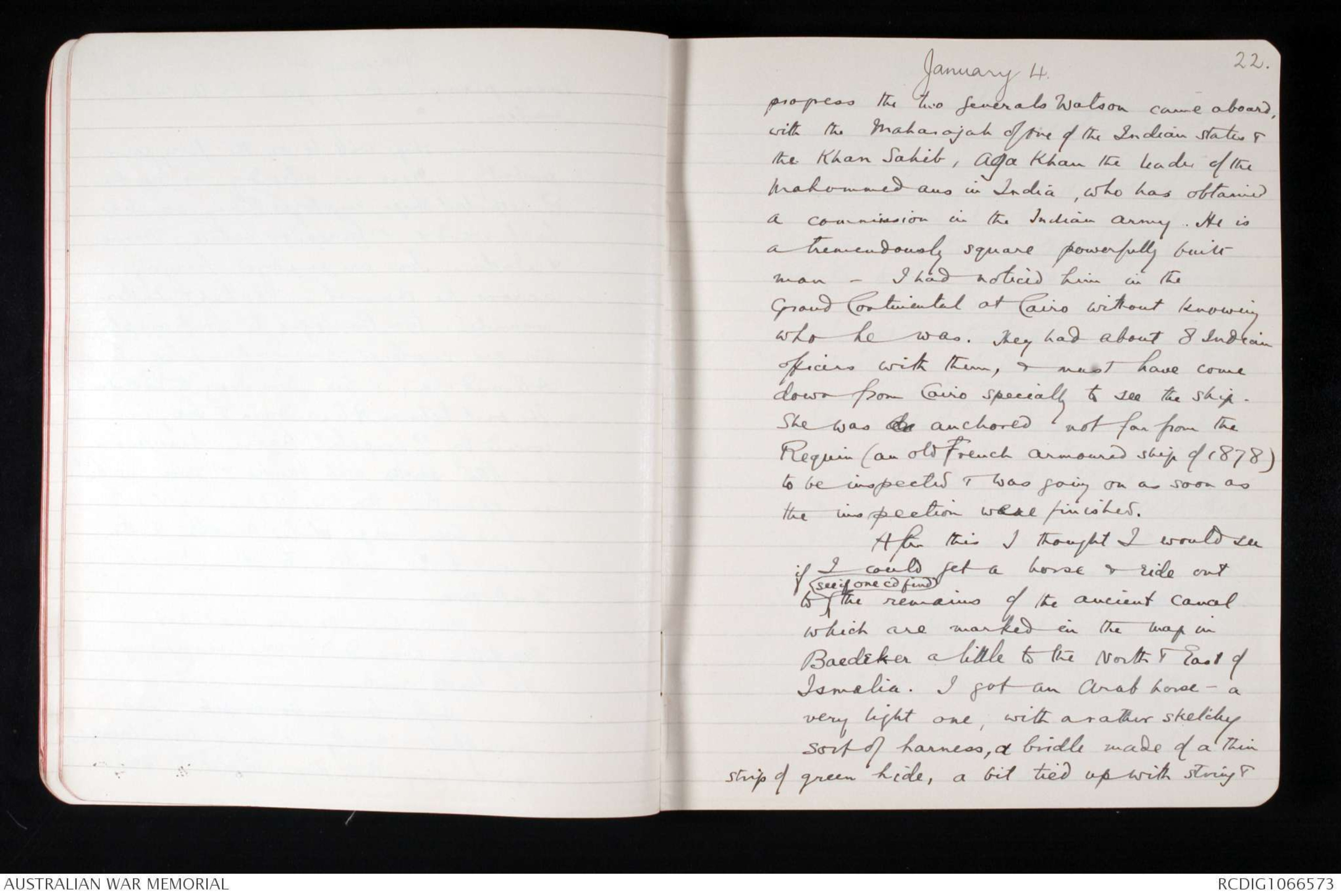
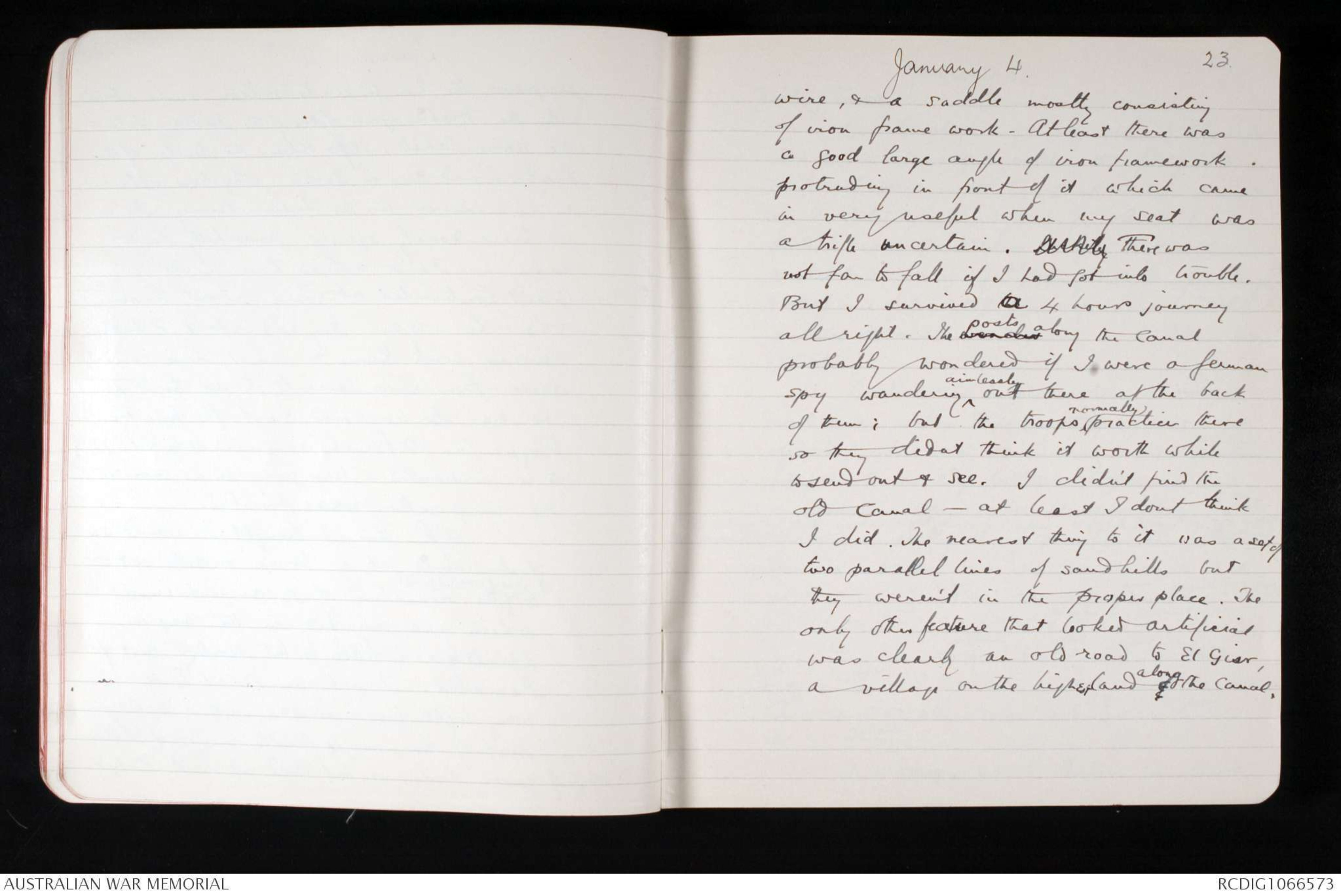
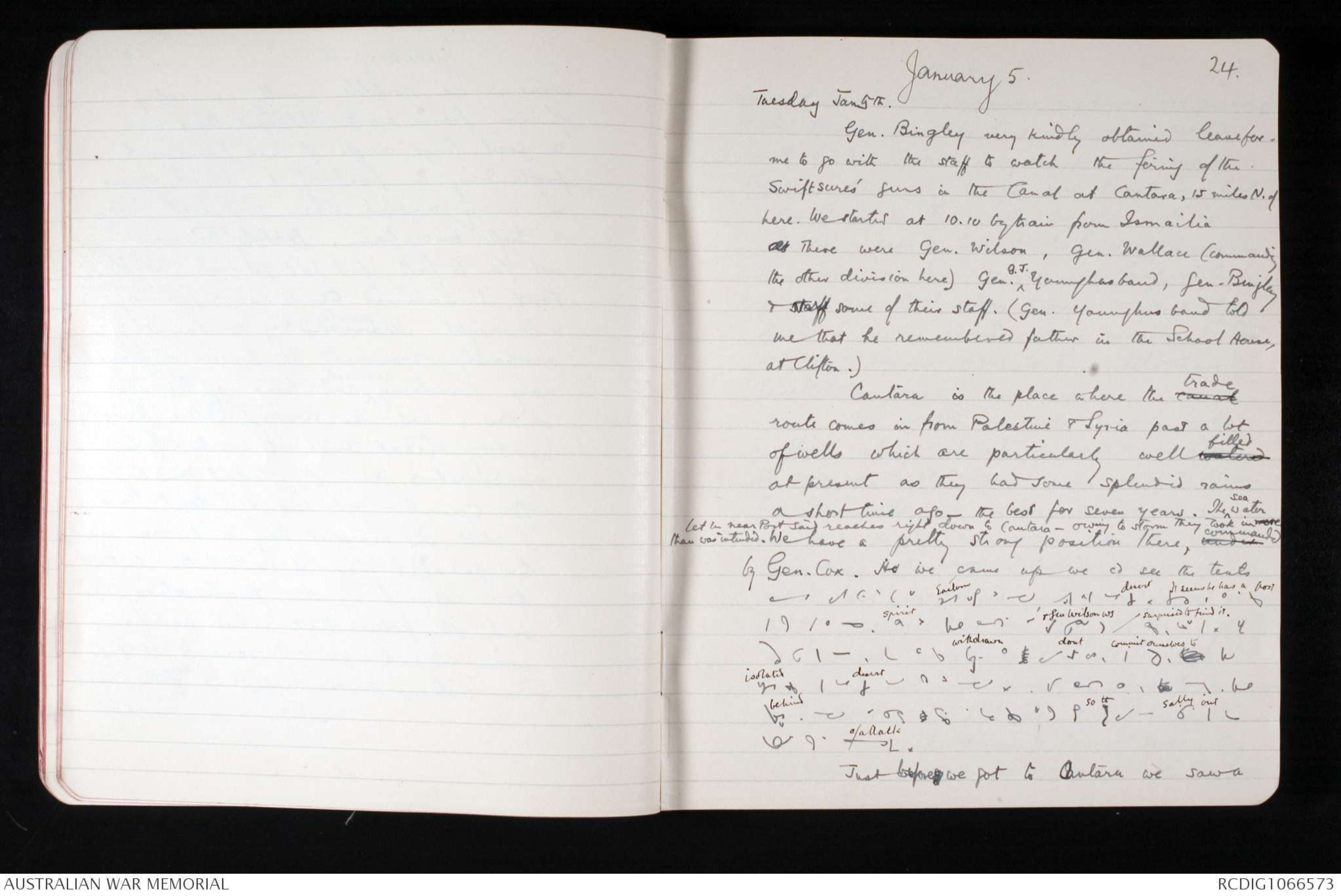
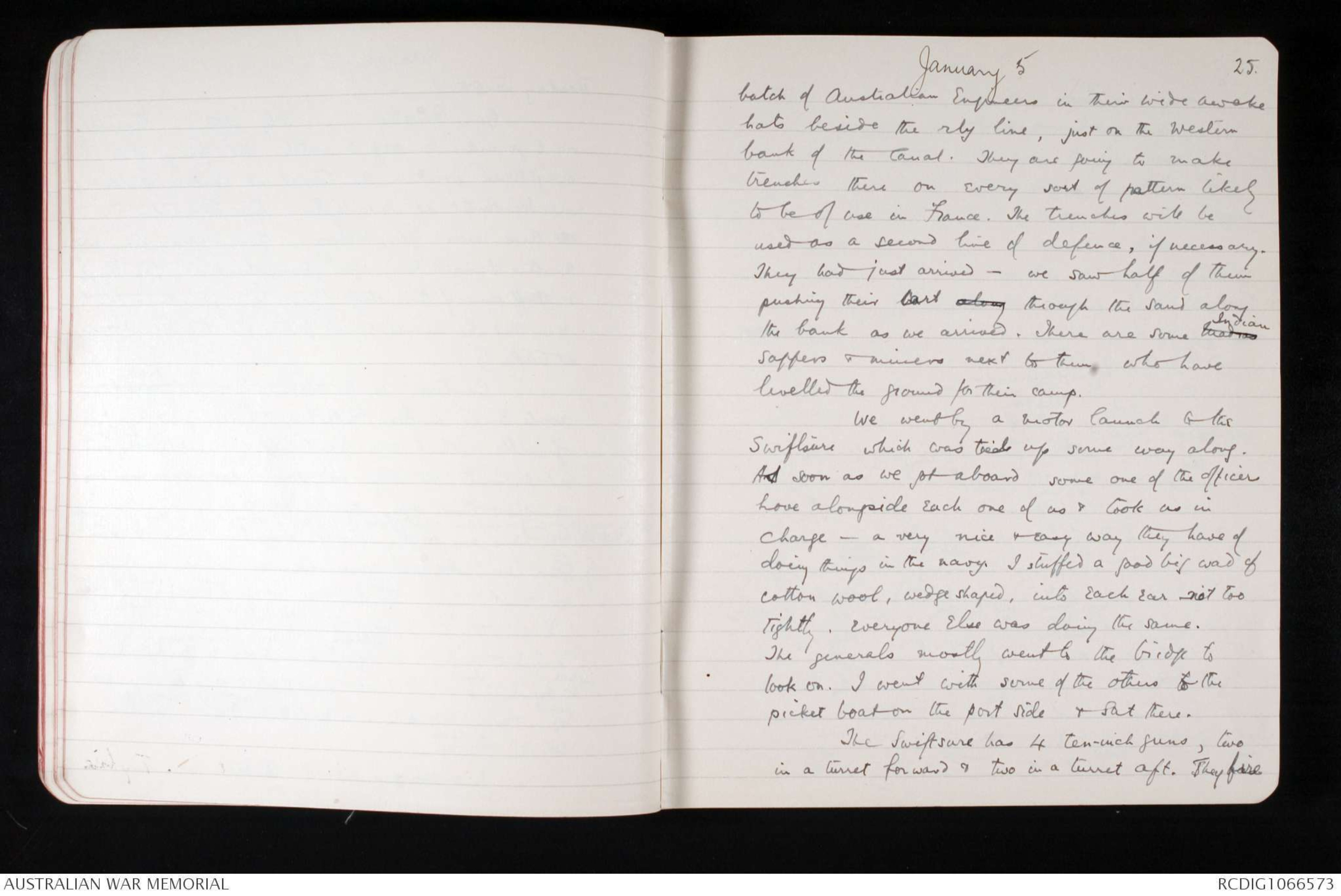
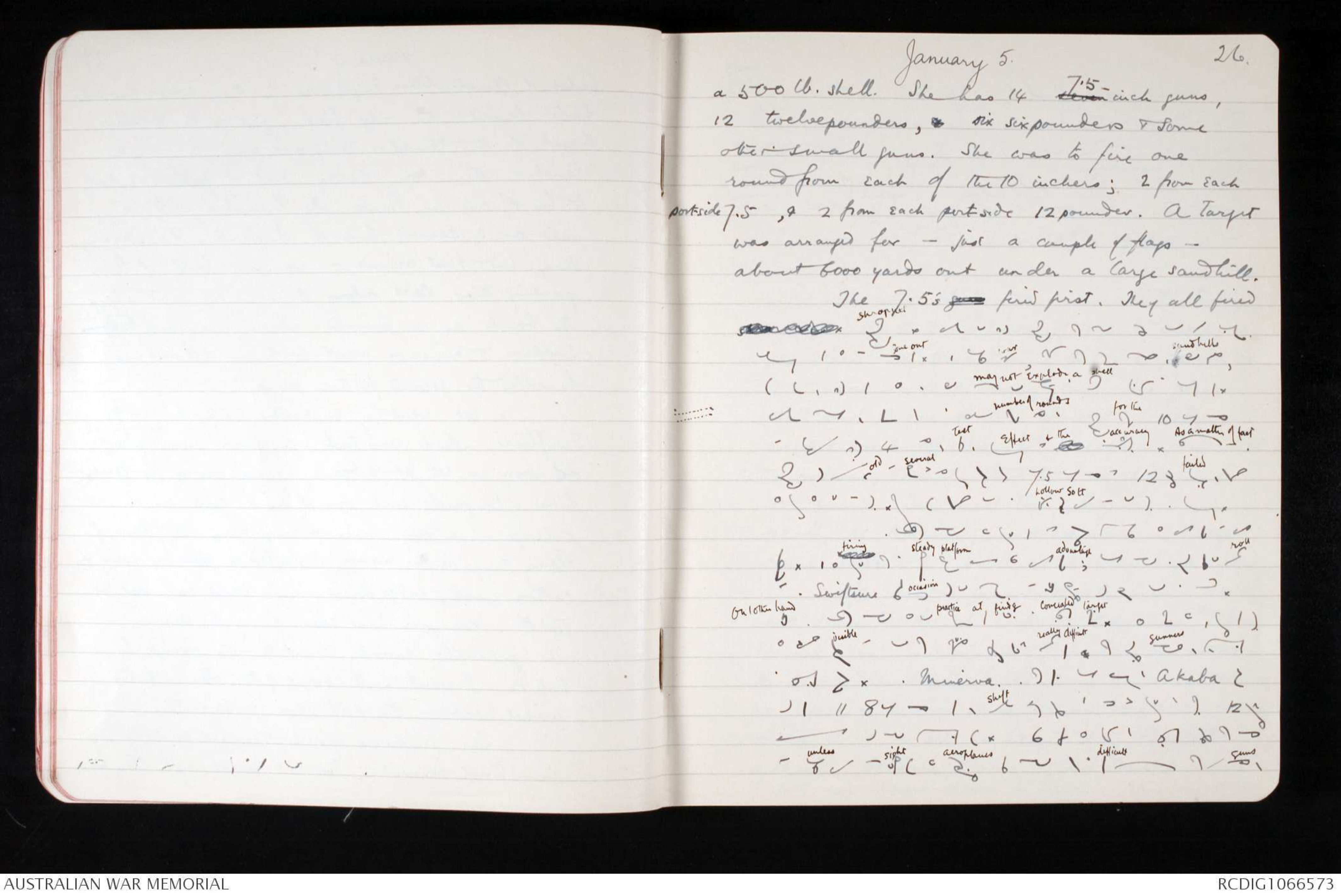
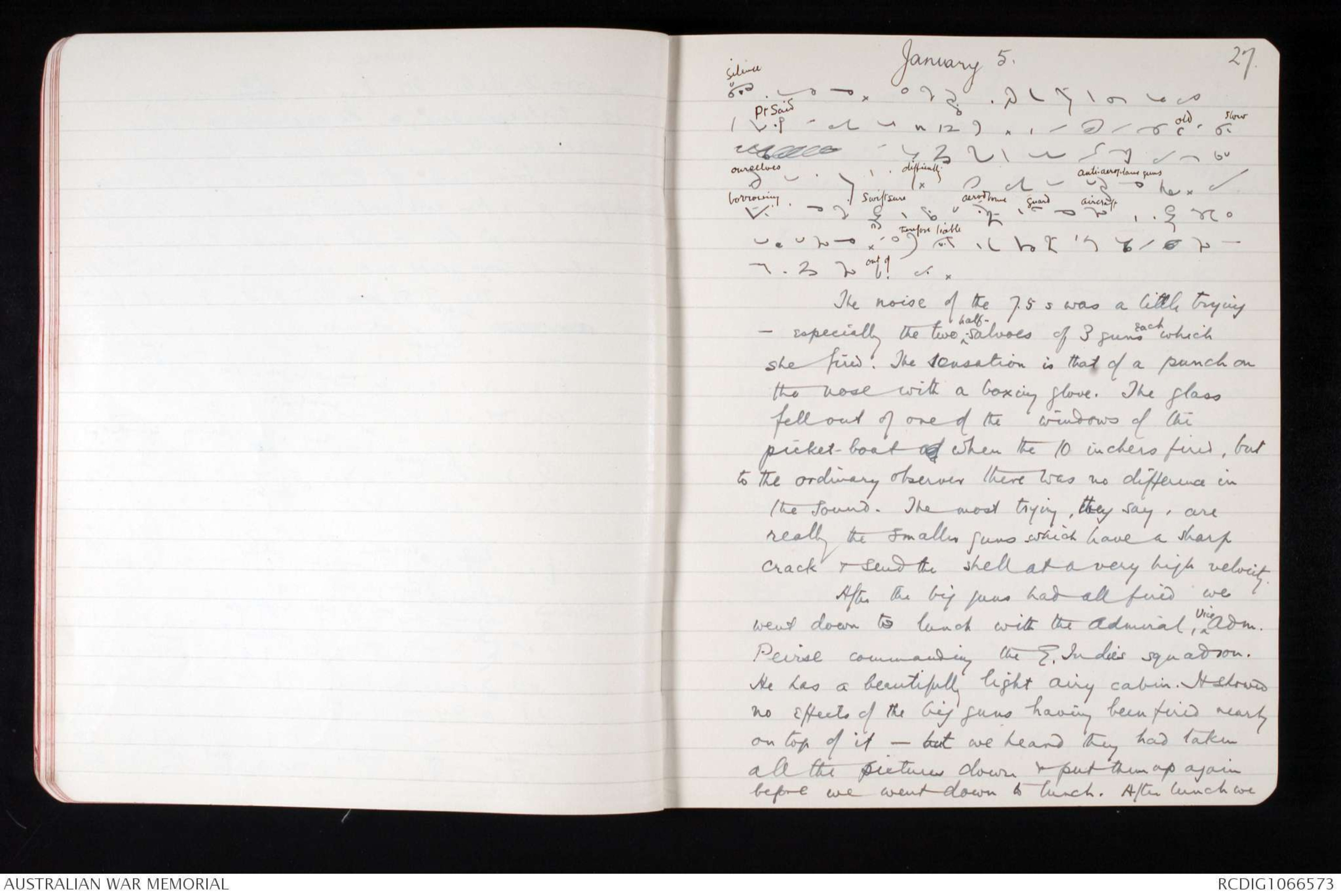
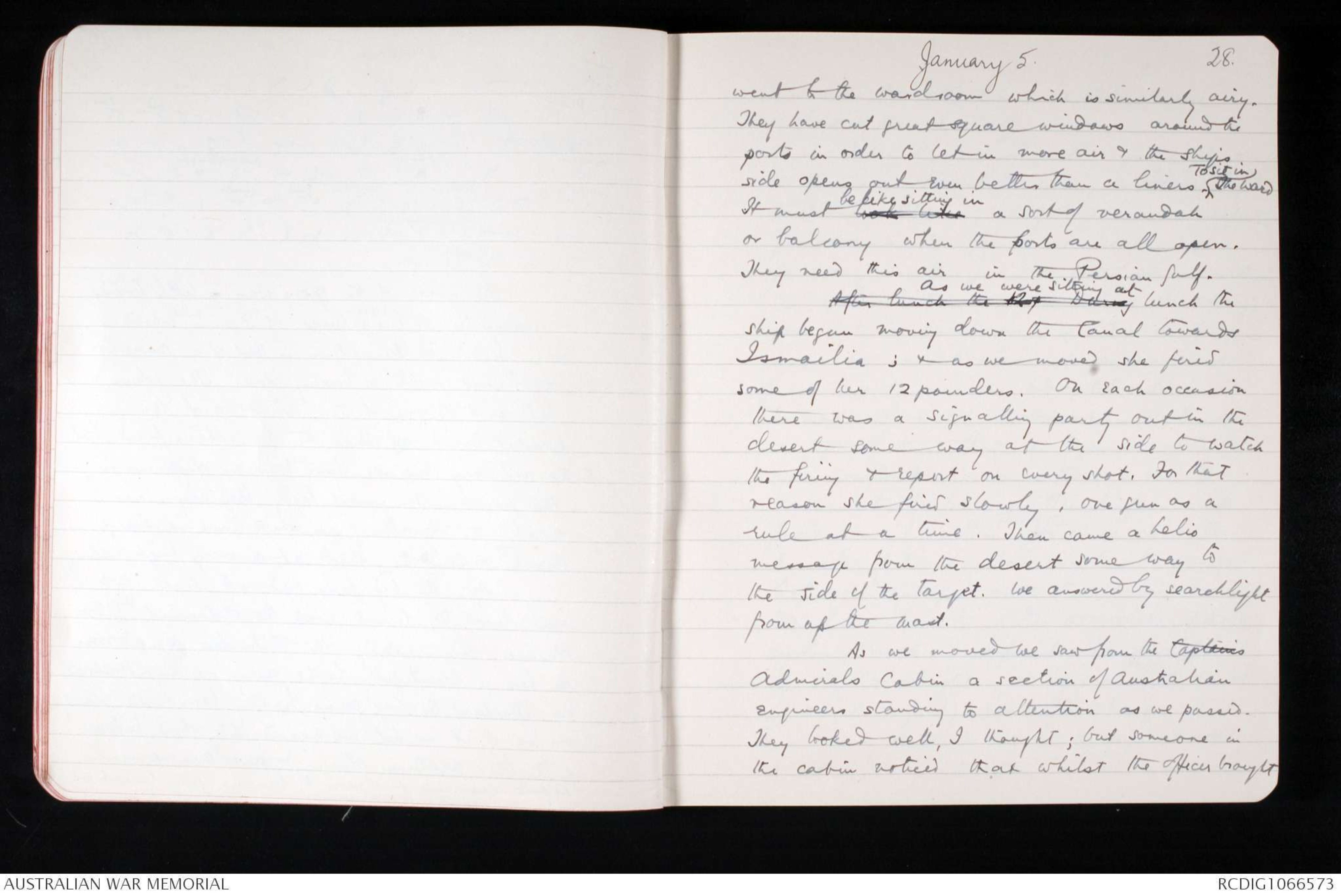
January 4. 19
of the Imperial Service Infantry Brigade
& the Frontier Brigade (Gen. Sir Geo. Younghusband) ;
& he is also senior officer of the two divisions
stationed along the Canal - they are not
organised as an Army corps but he
is the G.O.C. canal defences & so commands
the two. Gen. Harry Watson commands the
Imperial Service Infantry Brigade & his brother,
another & much taller Genl. Watson, the
Imperial service cavalry Brigade. They
were both on board the hospital ship & so wasseveral at least one other general - I dont remember
his name.
The hospital ship was the old Canadian
Pacific Lines Empress of India; now
turned into a she has still photos of the
Rocky Mtn forests & the companies
great hotels. She has a crew of Chinese,
with English officers, 4 Surgeons (∧ one a native
surgeon from the Court of the Maharajah
of Gwalior) 10 assistants - all qualified
native ∧ Indian doctors, - & a number of English
nurses. She has beds for just less than
300. The smoking room has been turned into
January 4 20
cabins for her medical officers – 4 big cabins.
The rest of the cabins, hatches etc have been
remodelled into about 10 beautifully
neat wards with rocking beds which can
either be locked or else left free to swing with
the ships movements. Some of the beds are
left specially wide for fellows with
broken legs. There is an operating room,
X Ray room, dark room, Dispensary
with a great deal of surgical stores,
a bacterial laboratory where slides can
be repaired; 2 isolation wards on deck;
& a special ward with 3 rooms beds for British
officers & a larger ward with about 20 beds
for native officers.
The whole ship has been min obtained
& paid for by the rulers of India (at
present either Gwalior or Scindia is doing Maharaja Scindia of Gwalior who gave
a similar ship during the Chinese trouble, is doing
everything & will collect it later ) - the
officers salaries are being paid for by
them. They have provided kits for the
men who come on board - pyjamas etc.,
& even kits to fit them out when they
leave the ship & go back to their regiments!
January 4. 21
Every penny is being paid by the native
rulers.
This ship will be on the ferry service
probably . There are already no less than
8 hospital ships employed taking wounded
backwards & forwards between France
& India. Four are employed ferrying
across the channel - British & Indian
wounded, from Boulogne to Southampton;
two are employed from Southampton to
Alexandria; & two from Suez to Bombay.
The part between Alexandria & Suez is
covered by 3 hospital trains. These trains
are fitted in the with bunks & even with
an operating theatre. A man might get
a bad haemorrhage whilst travelling & they
have to be able to deal with
it at once.
One had no idea that this
traffic in wounded was occupying
the trade routes.After leaving the hospit I had
breakfast - really it was a second breakfast -
on the hospital ship; whilst it was in
January 4. 22.
progress the two Generals Watson came aboard,
with the Maharajah of one of the Indian states &
the Khan Sahib, Aga Khan the leader of the
Mahommedans in India, who has obtained
a commission in the Indian army. He is
a tremendously square powerfully built
man – I had noticed him in the
Grand Continental at Cairo without knowing
who he was. They had about 8 Indian
officers with them, & must have come
down from Cairo specially to see the ship.
She was do anchored not far from the
Requin (an old French armoured ship of 1878)
to be inspected & was going on as soon as
the inspection were finished.
After this I thought I would see
if I could get a horse & ride out
to ∧ see if one cd find the remains of the ancient canal
which are marked in the map in
Baedeker a little to the North & East of
Ismalia. I got an Arab horse - a
very light one, with a rather sketchy
sort of harness, & bridle made of a thin
strip of green hide, a bit tied up with string &
January 4. 23.
wire, & a saddle mostly consisting
of iron frame work. At least there was
a good large angle of iron framework
protruding in front of it which came
in very useful when my seat was
a trifle uncertain. Shakily There was
not far to fall if I had got into trouble.
But I survived the a 4 hours journey
all right. The trenches posts along the Canal
probably wondered if I were a German
spy wandering ∧ aimlessly out there at the back
of them; but the troops ∧ normally practice there
so they didn't think it worth while
to send out & see. I didn't find the
old canal - at least I don't think
I did. The nearest thing to it was a set of
two parallel lines of sandhills but
they weren't in the proper place. The
only other feature that looked artificial
was clearly an old road to El Gisr,
a village on the higher land along of the Canal.
January 5. 24.
Tuesday Jan 5th.
Gen. Bingley very kindly obtained leave for
me to go with the staff to watch the firing of the
Swiftsure's guns in the Canal at Cantara, 15 miles N. of
here. We started at 10.10 by train from Ismailiaat There were Gen. Wilson, Gen. Wallace (commanding
the other division here) Gen. G. J. Younghusband, Gen. Bingley
& staff some of their staff. (Gen. Younghusband told
me that he remembered father in the School House,
at Clifton.)
Cantara is the place where the canal trade
route comes in from Palestine & Syria past a lot
of wells which are particularly well watered filled
at present as they had some splendid rains
a short time ago - the best for seven years. The ∧ sea water
let in near Port Said reaches right down to Cantara - owing to storm they took in more
than was intended. We have a pretty strong position there, under commanded
by Gen. Cox. As we came up we cd see the tents
- one lot of them on the eastern side of the canal, right out in the desert. It seems he has a post
which very much is against the spirit of the defence scheme and General Wilson was rather surprised to find it. I think
orders will be given to have that post withdrawn as it is the we don't want to commit ourselves to have to defend
isolated posts out in the desert in front of the canal. The whole scheme is to keep the defence
behind the canal and simply x place a few posts on the other side so that we can sally out if
necessary for a counterattack.
Just before we got to Cantara we saw a
January 5 25.
batch of Australian Engineers in their wide awake
hats beside the rly line, just on the Western
bank of the Canal. They are going to make
trenches there on every sort of pattern likely
to be of use in France. The trenches will be
used as a second line of defence, if necessary.
They had just arrived - we saw half of them
pushing their cart along through the sand along
the bank as we arrived. There are some Madras Indian
sappers & miners next to them, who have
levelled the ground for their camp.
We went by a motor launch to the
Swiftsure which was tied up some way along.
As soon as we got aboard some one of the officers
hove alongside each one of us & took us in
charge - a very nice & easy way they have of
doing things in the navy. I stuffed a good big wad of
cotton wool, wedge shaped, into each ear not too
tightly. Everyone else was doing the same.
The generals mostly went to the bridge to
look on. I went with some of the others to the
picket boat on the port side & sat there.
The Swiftsure has 4 ten-inch guns, two
in a turret forward & two in a turret aft. They fire
January 5. 26.
a 500lb. shell. She has 14 seven 7.5-inch guns,
12 twelvepounders, & six sixpounders & some
other small guns. She was to fire one
round from each of the 10 inchers; 2 from each
portside 7.5, & 2 from each port side 12 pounder. A target
was arranged for - just a couple of flags -
about 6000 yards out under a large sandhill.
The 7.5's guns fired first. They all fired xxx shrapnel. We have not used shrapnel for many years in our navy
in fact it has all gone out. But in this war, particularly for [[?]] amongst the sand hills,
we have managed to dig up a certain number of rounds of shrapnel for the 10 inch guns
and they were using 4 rounds to test the effect and the accuracy. As a matter of fact the
shrapnel was rather old and several of the rounds fired both for the 7.5 inch guns and the 12 pounders failed to burst
as far as I could see. Perhaps they burst in a hollow so that we could not see the effect.
The naval gunner would fire it and the [[?]] and this has one advantage and one
disadvantage. He is firing from a steady platform - that is one advantage; in the canal the ship does not roll
and the Swiftsure on this occasion was not moving and I don't suppose she would be in a [[?]].
On the other hand the naval gunner has no practice at finding a concealed target. His target when he fires at sea
is always visible and in their trials it has been found really difficult for ships gunners to locate
a hidden object. The Minerva. the other day in the Gulf of Akaba although
she had 11 8-inch guns had to shift her position on account of the fire of three 12 pounders
- she could not locate them. This desert is full of concealed positions for guns
and unless we can sight them with aeroplanes it is going to be a difficult matter for our guns to
January 5. 27.
silence the enemy's guns. As for the aeroplanes the French have brought up some new ones
at Port Said and we have now about 12 there. But our machines are mostly old and slowand unless we can and if the Germans bring up anything really modern we might find
ourselves in a bit of a difficulty. Also we have no anti-aeroplane guns at present. We are
borrowing a gun from the Swiftsure to place on the aerodrome to guard against aircraft but the Swiftsure herself has
no anti-aircraft guns. And is therefore liable to have bombs dropped on her unless our aircraft can
keep the German aircraft out of the way.
The noise of the 7.5 s was a little trying
- especially the two ∧ half-salvoes of 3 guns each which
she fired. The sensation is that of a punch on
the nose with a boxing glove. The glass
fell out of one of the windows of the
picket-boat of when the 10 inchers fired, but
to the ordinary observer there was no difference in
the sound. The most trying, they say, are
really the smaller guns which have a sharp
crack & send the shell at a very high velocity.
After the big guns had all fired we
went down to lunch with the Admiral, ∧ Vice Adm.
Peirse commanding the E. Indies squadron.
He has a beautifully light airy cabin. It showed
no effects of the big guns having been fired nearly
on top of it – but we heard they had taken
all the pictures down & put them up again
before we went down to lunch. After lunch we
January 5. 28.
went to the wardroom which is similarly airy.
They have cut great square windows around the
ports in order to let in more air & the ships
side opens out even better than a liners. ∧ To sit in the ward
It must look like be like sitting in a sort of verandah
or balcony when the ports are all open.
They need this air in the Persian Gulf.After lunch the ship During As we were sitting at lunch the
ship began moving down the Canal towards
Ismailia; & as we moved she fired
some of her 12 pounders. On each occasion
there was a signalling party out in the
desert some way at the side to watch
the firing & report on every shot. For that
reason she fires slowly, one gun as a
rule at a time. Then came a helio
message from the desert some way to
the side of the target. We answered by searchlight
from up the mast.
As we moved we saw from the Captains
Admirals Cabin a section of Australian
engineers standing to attention as we passed.
They looked well, I thought; but someone in
the cabin noticed that whilst the officer brought
 Sue Harris
Sue HarrisThis transcription item is now locked to you for editing. To release the lock either Save your changes or Cancel.
This lock will be automatically released after 60 minutes of inactivity.